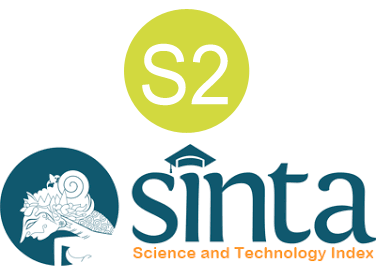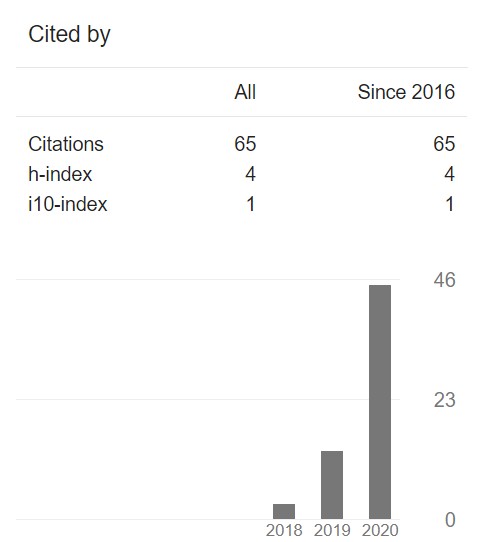The Influence of Information Technology Competence and Educational Level on Work Productivity at the University
DOI:
https://doi.org/10.37680/qalamuna.v16i2.4080Keywords:
Information technology, college, administrators' educationAbstract
The competence of educational staff in information technology is essential to finishing a job at a university. Good information technology competence can help them complete the work faster and more effectively. This study investigates the influence of communication competence and education level on work productivity at Sebelas Maret University. Two hundred ten respondents were involved, consisting of 125 male and 85 female staff. Pearson correlation is used for validation, and Cronbach's alpha is used for reliability tests. All items are valid and reliable (α =.05.) The data were analyzed using multiple linear regressions. The result shows that simultaneously, the two independent variables have a significant effect on the dependent variable (F = 9.63, p <.05). Information technology competence has a significant effect on work productivity (t = 4.64, p <.05). Education level has a significant effect on work productivity (t = 2.48, p <.05). Generally, it can be concluded that the information technology competence and educational level of staff affect work productivity.
Downloads
References
Abdel Hadi, S., Kersting, M., Klehe, U. C., Deckenbach, M., & Häusser, J. A. (2023). Relationships between proactive personality, work locus of control, and vocational satisfaction: The role of level of education. Heliyon, 9(2), e13283. https://doi.org/10.1016/j.heliyon.2023.e13283
Akter, S. N., Sinthia, A. K., Roy, P., Razzaque, Md. A., Hassan, M. M., Pupo, F., & Fortino, G. (2023). Reputation-aware optimal team formation for collaborative software crowdsourcing in industry 5.0. Journal of King Saud University - Computer and Information Sciences, 35(8), 101710. https://doi.org/10.1016/j.jksuci.2023.101710
Astarina, I., Hapsila, A., & Ramadan, G. (2020). EFFECT OF EDUCATION LEVEL AND WORK ENVIRONMENT ON EMPLOYEE PRODUCTIVITY IN PT.TESO INDAH INDRAGIRI HULU REGENCY. Jurnal Manajemen Dan Bisnis, 9(2), 73–81. https://doi.org/10.34006/jmbi.v9i2.235
Bloom, N., Garicano, L., Sadun, R., & Van Reenen, J. (2014). The Distinct Effects of Information Technology and Communication Technology on Firm Organization. Management Science, 60(12), 2859–2885. https://doi.org/10.1287/mnsc.2014.2013
Cai, W., Lysova, E. I., Bossink, B. A. G., Khapova, S. N., & Wang, W. (2019). Psychological capital and self‐reported employee creativity: The moderating role of supervisor support and job characteristics. Creativity and Innovation Management, 28(1), 30–41. https://doi.org/10.1111/caim.12277
Choi, S., Li, H., & Ogawa, K. (2023). Upper secondary vocational education and decent work in Indonesia: A gender comparison. International Journal of Educational Development, 101, 102833. https://doi.org/10.1016/j.ijedudev.2023.102833
D. Fonseca, M. Conde, & F. García-Peñalvo. (2017). Improving the information society skills: Is knowledge accessible for all? Computer ScienceUniversal Access in the Information Society. https://doi.org/10.1007/s10209-017-0548-6
David, I., Aslam, K., Malavolta, I., & Lago, P. (2023). Collaborative Model-Driven Software Engineering—A systematic survey of practices and needs in industry. Journal of Systems and Software, 199, 111626. https://doi.org/10.1016/j.jss.2023.111626
De Schepper, A., Clycq, N., & Kyndt, E. (2023). A systematic review of social networks in transitioning from higher education to work. Educational Research Review, 40, 100551. https://doi.org/10.1016/j.edurev.2023.100551
Elvira, Q., Imants, J., deMaeyer, S., & Segers, M. (2015). The quality of high school students’ problem solving from an expertise development perspective. Citizenship, Social and Economics Education, 14(3), 172–192. https://doi.org/10.1177/2047173416630012
Green, A., & Pensiero, N. (2016). The effects of upper-secondary education and training systems on skills inequality. A quasi-cohort analysis using PISA 2000 and the OECD survey of adult skills. British Educational Research Journal, 42(5), 756–779. https://doi.org/10.1002/berj.3236
Guo, J., Cui, L., Sun, S. L., & Zou, B. (2022). How to innovate continuously? Conceptualizing generative capability. Journal of Innovation & Knowledge, 7(2), 100177. https://doi.org/10.1016/j.jik.2022.100177
Haislip, J. Z., & Richardson, V. J. (2018). The Effect of CEO IT Expertise on the Information Environment: Evidence from Earnings Forecasts and Announcements. Journal of Information Systems, 32(2), 71–94. https://doi.org/10.2308/isys-51796
Hart, C., Da Costa, C., D’Souza, D., Kimpton, A., & Ljbusic, J. (2021). Exploring higher education students’ critical thinking skills through content analysis. Thinking Skills and Creativity, 41, 100877. https://doi.org/10.1016/j.tsc.2021.100877
Hina, S., Panneer Selvam, D. D. D., & Lowry, P. B. (2019). Institutional governance and protection motivation: Theoretical insights into shaping employees’ security compliance behavior in higher education institutions in the developing world. Computers & Security, 87, 101594. https://doi.org/10.1016/j.cose.2019.101594
Holgeid, K. K., Krogstie, J., Mikalef, P., Saur, E. E., & Sjøberg, D. I. K. (2022). Benefits management and Information Technology work distribution. IET Software, 16(4), 438–454. https://doi.org/10.1049/sfw2.12062
Ismet, A. (2018). Communication skills of students in fine arts departments of education faculties. Educational Research and Reviews, 13(20), 688–695. https://doi.org/10.5897/ERR2018.3611
Jian, X. (2024). Research on Construction and Application of Network Learning Space for Logistics Information Technology Specialized Courses on Higher Education Resource Platforms. Applied Mathematics and Nonlinear Sciences, 9(1), 20241255. https://doi.org/10.2478/amns-2024-1255
John Paul C. Flaminiano, Jamil Paolo S. Francisco, & Sunshine Therese S. Alcantara. (2022). Information technology as a catalyst to the effects of education on labour productivity. Information Technology for Development, 28(4). https://doi.org/10.1080/02681102.2021.2008851
Kafri, B. A. (2022). Critical thinking (CT) in sustainable higher education: Ensuring consistent CT perception-practice and identifying gaps between college instructors’ and students’ perceptions in advanced academic writing courses in the UAE. Thinking Skills and Creativity, 46, 101182. https://doi.org/10.1016/j.tsc.2022.101182
Kocak, O., Coban, M., Aydin, A., & Cakmak, N. (2021). The mediating role of critical thinking and cooperativity in the 21st century skills of higher education students. Thinking Skills and Creativity, 42, 100967. https://doi.org/10.1016/j.tsc.2021.100967
Lee, G., & Pang, M.-S. (2020). Tech Talent Crisis? The Impact of IT Human Capital and Decision-Making Authority on IT Project Performance. SSRN Electronic Journal. https://doi.org/10.2139/ssrn.3608768
Liu, S., Jin, Y., & Kong, D. (2023). Access to overseas information and domestic value added: Evidence from China. Journal of International Money and Finance, 138, 102941. https://doi.org/10.1016/j.jimonfin.2023.102941
Marchesani, F., Masciarelli, F., & Bikfalvi, A. (2023). Smart city as a hub for talent and innovative companies: Exploring the (dis) advantages of digital technology implementation in cities. Technological Forecasting and Social Change, 193, 122636. https://doi.org/10.1016/j.techfore.2023.122636
Meng, Y., Qu, Z., Muhammad, G., & Tiwari, P. (2023). Secure and efficient data transmission based on quantum dialogue with hyperentangled states in cloud office. Internet of Things, 100911. https://doi.org/10.1016/j.iot.2023.100911
Montero Guerra, J. M., Danvila-del-Valle, I., & Méndez-Suárez, M. (2023). The impact of digital transformation on talent management. Technological Forecasting and Social Change, 188, 122291. https://doi.org/10.1016/j.techfore.2022.122291
Naved, M., Sanchez, D. T., Dela Cruz, A. P., Peconcillo, L. B., Peteros, E. D., & Tenerife, J. J. L. (2022). Identifying the role of cloud computing technology in management of educational institutions. Materials Today: Proceedings, 51, 2309–2312. https://doi.org/10.1016/j.matpr.2021.11.414
Neziraj, E. Q., & Berisha Shaqiri, A. (2018). The impact of information technology in decision making process of companies in Kosovo. Informatologia, 51(1–2), 13–23. https://doi.org/10.32914/i.51.1-2.2
Norton, L., Ciervo, J., Lobanov, V. S., & Agrafiotis, D. K. (2020). Xcellerate Investigator Portal: A New Web-Based Tool for Online Delivery of Central Laboratory Data, Reports, and Communications to Clinical Sites. SLAS Technology, 25(5), 427–435. https://doi.org/10.1177/2472630320942200
PANCASILA, I., HARYONO, S., & SULISTYO, B. A. (2020). Effects of Work Motivation and Leadership toward Work Satisfaction and Employee Performance: Evidence from Indonesia. The Journal of Asian Finance, Economics and Business, 7(6), 387–397. https://doi.org/10.13106/JAFEB.2020.VOL7.NO6.387
Patil, L. (2023). The business of development: The institutional rationales of technology corporations in educational development. International Journal of Educational Development, 97, 102712. https://doi.org/10.1016/j.ijedudev.2022.102712
Prat, F. (2022). Information Technology: Has It Made a Change in Your Company’s Productivity? Journal of Petrolium Technology, 54(04). https://doi.org/10.2118/0402-0034-JPT
Said Ghaleb. (2017). Automatic Customer Counter and Payment Tool for Shopping Centers and commercial spaces. International Research Journal of Engineering and Technology (IRJET), 4(06), 1818.
Salkić, H., Omerović, A., Salkić, A., & Kvasina, M. (2023). Enhancing Economic Management with Information Technology: Insights from Covid-19 in Bosnia and Herzegovina Through the Lens of Machine Learning Methods. ECONOMICS, 11(2), 209–223. https://doi.org/10.2478/eoik-2023-0048
Setiadi, P. B., Ursula, R., Ti, R., & Setini, M. (2020). Labour Productivity, Work Experience, Age and Education: The Case of Lurik Weaving Industry in Klaten, Indonesia. Webology, 17(2), 487–502. https://doi.org/10.14704/WEB/V17I2/WEB17047
Sloot, R. N. F., Troje, D., Voordijk, J. T., & Volker, L. (2024). Change in a project-based organization: The mutual shaping of institutional logics and change programs. International Journal of Project Management, 42(3), 102589. https://doi.org/10.1016/j.ijproman.2024.102589
Sylqa, D. (2022). The Relation Between Organizational Learning and Information Technology in Companies with International Activities During the Covid-19 Pandemic. Quality - Access to Success, 23(186). https://doi.org/10.47750/QAS/23.186.37
Toader, E., Firtescu, B., Roman, A., & Anton, S. (2018). Impact of Information and Communication Technology Infrastructure on Economic Growth: An Empirical Assessment for the EU Countries. Sustainability, 10(10), 3750. https://doi.org/10.3390/su10103750
Turalbayeva, A., Zhubandykova, A., Nabuova, R., Buzaubakova, K., Mailybaeva, G., & Abdullina, G. (2021). Formation of information culture of students through information technology. World Journal on Educational Technology: Current Issues, 13(4), 794–805. https://doi.org/10.18844/wjet.v13i4.6265
Van Der Voort, H., Van Bulderen, S., Cunningham, S., & Janssen, M. (2021). Data science as knowledge creation a framework for synergies between data analysts and domain professionals. Technological Forecasting and Social Change, 173, 121160. https://doi.org/10.1016/j.techfore.2021.121160
Downloads
Published
How to Cite
Issue
Section
License
Authors who submit manuscript retain its copyright and grant publisher right of first publication licensed under a Creative Commons Attribution-ShareAlike 4.0 International License (CC BY-SA 4.0) that allows others to access (search, read, download, and cite), share (copy and redistribute the material in any medium or format) and adapt (remix, transform, and build upon any material) the work for any lawful purpose, even commercially with an acknowledgement of the work's authorship and initial publication in Qalamuna: Jurnal Pendidikan, Sosial, dan Agama.












